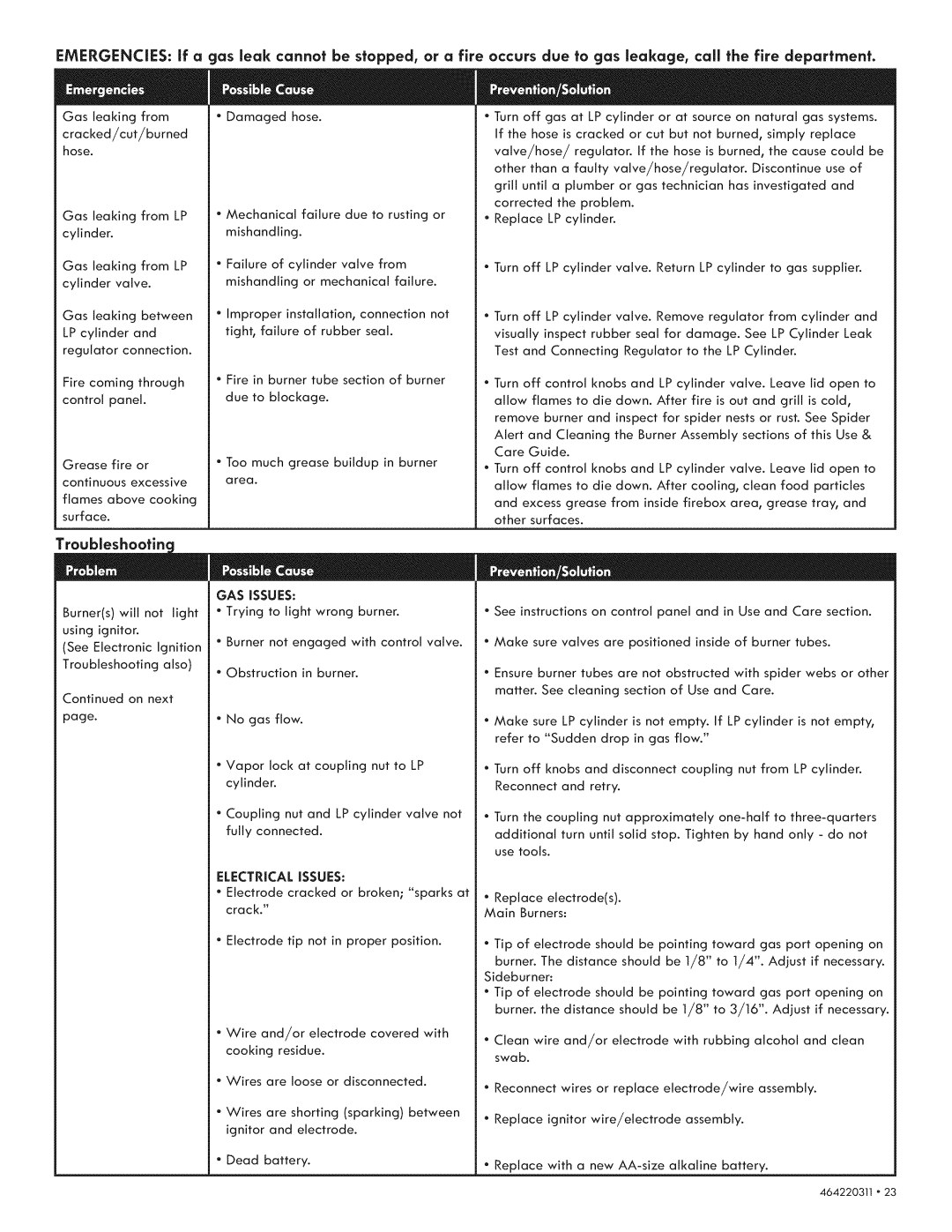
EMERGENCIES: Jf a gas leak cannot be stopped, or a fire occurs due to gas leakage, call the fire department.
Gas leaking from
cracked/cut/burned
hose.
Gas leaking from LP cylinder.
Gas leaking from LP cylinder valve.
Gas leaking between
LP cylinder and
regulator connection.
Fire coming through control panel.
Grease fire or
continuous excessive
flames above cooking
surface.
• Damaged hose.
•Mechanical failure due to rusting or mishandling.
•Failure of cylinder valve from mishandling or mechanical failure.
•Improper installation, connection not tight, failure of rubber seal.
•Fire in burner tube section of burner due to blockage.
•Too much grease buildup in burner area.
•Turn off gas at LP cylinder or at source on natural gas systems. If the hose is cracked or cut but not burned, simply replace
valve!hose/regulator. | If the hose is | burned, the cause | could be | |
other than | a faulty | valve!hose!regulator. | Discontinue | use of |
grill until a | plumber | or gas technician | has investigated | and |
corrected | the problem. |
|
| |
•Replace LP cylinder.
•Turn off LP cylinder valve. Return LP cylinder to gas supplier.
•Turn off LP cylinder valve. Remove regulator from cylinder and visually inspect rubber seal for damage. See LP Cylinder Leak Test and Connecting Regulator to the LP Cylinder.
•Turn off control knobs and LP cylinder valve. Leave lid open to allow flames to die down. After fire is out and grill is cold, remove burner and inspect for spider nests or rust. See Spider
Alert and Cleaning the Burner Assembly sections of this Use & Care Guide.
•Turn off control knobs and LP cylinder valve. Leave lid open to allow flames to die down. After cooling, clean food particles and excess grease from inside firebox area, grease tray, and other surfaces.
Troubleshootinc
Burner(s) will not light using ignitor.
(See Electronic Ignition
Troubleshooting also)
Continued on next
page.
GAS ISSUES: |
|
|
|
|
|
|
|
|
|
|
|
| ||
" Trying | to | light wrong | burner. | • | See instructions on | control | panel | and | in Use and | Care section. | ||||
• Burner | not | engaged | with control valve. | • | Make | sure valves | are | positioned | inside | of burner | tubes. |
| ||
• Obstruction | in burner. | • | Ensure burner tubes are not obstructed | with spider webs | or other | |||||||||
|
|
|
|
| matter. See cleaning section of Use and Care. |
|
| |||||||
• No gas | flow. |
| • | Make | sure LP cylinder | is | not empty. | If | LP cylinder | is not | empty, | |||
|
|
|
|
| refer to _Sudden drop in gas flow." |
|
|
|
| |||||
•Vapor lock at coupling nut to LP cylinder.
•Coupling nut and LP cylinder valve not fully connected.
ELECTRICAL ISSUES:
•Electrode cracked or broken; _sparks at crack."
•Electrode tip not in proper position.
•Wire and!or electrode covered with cooking residue.
•Wires are loose or disconnected.
•Wires are shorting (sparking) between ignitor and electrode.
•Dead battery.
•Turn off knobs and disconnect coupling nut from LP cylinder. Reconnect and retry.
•Turn the coupling nut approximately
additional turn until solid stop. Tighten by hand only - do not use tools.
•Replace electrode(s).
Main Burners:
•Tip of electrode should be pointing toward gas port opening on
burner. The distance should be 1/8" to 1/4". Adjust if necessary. Sideburner:
•Tip of electrode should be pointing toward gas port opening on burner, the distance should be 1/8" to 3/16". Adjust if necessary.
•Clean wire and/or electrode with rubbing alcohol and clean swab.
•Reconnect wires or replace electrode/wire assembly.
•Replace ignitor wire/electrode assembly.
•Replace with a new
464220311 o 23
